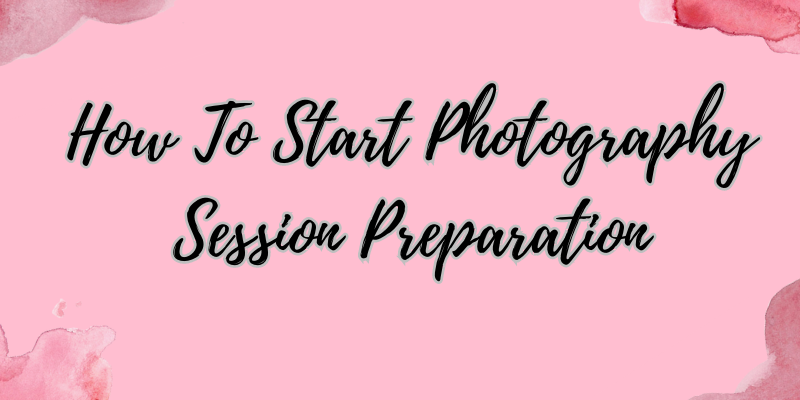Photography sessions can be exciting and fulfilling, but proper preparation is essential for a successful shoot. Whether you are a professional photographer or an enthusiast, this article will provide you with valuable tips and tricks to ensure your photography session goes smoothly. From planning and equipment preparation to location scouting and communication with your subjects, we will cover all the necessary aspects for a successful shoot.
Are You Looking for a Minot Photographer in North Dakota?

1. Understanding the Purpose of the Shoot
Before you begin preparing for a photography session, it’s crucial to understand the purpose and goals of the shoot. Determine the type of photography you will be focusing on, whether it’s portraits, landscapes, fashion, or any other genre. Understanding the purpose will help you plan the session effectively and capture the desired shots.
2. Planning and Conceptualizing the Session
Start by brainstorming ideas and concepts for your photography session. Consider the theme, mood, and overall style you want to achieve. Create a shot list or a storyboard to outline the specific shots you intend to capture. This will serve as a roadmap during the session and ensure you don’t miss any important moments.
3. Selecting the Right Equipment
Choosing the appropriate equipment is vital for a successful photography session. Assess the requirements of your shoot and select the right camera, lenses, and accessories accordingly. Make sure your equipment is in good working condition and fully charged. Additionally, bring spare batteries, memory cards, and any other necessary accessories.
4. Choosing the Ideal Location
Selecting the right location can significantly enhance the quality of your photographs. Consider the theme and style of your shoot when scouting for locations. Look for interesting backdrops, natural lighting conditions, and unique features that will complement your subject. If shooting indoors, ensure that the location provides ample space and flexibility for your creative vision.
5. Communicating with Your Subjects
Effective communication with your subjects is key to capturing their true essence and creating a comfortable environment. Establish a rapport with them beforehand and discuss your vision for the shoot. Encourage them to share their ideas and preferences. Clear communication will help both you and your subjects feel at ease and result in more natural and authentic photographs.
6. Organizing Props and Accessories
If your photography session requires props or accessories, make sure you gather and organize them in advance. Prepare a checklist to ensure you have all the necessary items on the day of the shoot. Arrange the props in a way that complements the overall theme and doesn’t overwhelm the composition.
7. Preparing for Different Lighting Conditions
Lighting plays a crucial role in photography, and being prepared for different lighting conditions is essential. Familiarize yourself with various lighting techniques and adapt your equipment and settings accordingly. Carry reflectors, diffusers, or artificial lighting equipment to control and manipulate light effectively.
8. Dressing Appropriately for the Session
As a photographer, it’s important to dress appropriately for the session. Opt for comfortable clothing that allows freedom of movement while still maintaining a professional appearance. Consider the shooting environment and choose attire that suits the mood and style of the session.
9. Ensuring Backup and Safety Measures
Photography sessions can be unpredictable, so it’s crucial to have backup plans and safety measures in place. Carry extra memory cards, batteries, and even an additional camera if possible. Be aware of your surroundings and take necessary precautions to ensure the safety of yourself, your subjects, and your equipment.
10. Capturing Candid Moments
While posed shots have their place, candid moments often evoke genuine emotions and create compelling photographs. Encourage your subjects to relax and be themselves during the session. Capture the in-between moments when they are unaware of the camera, as these can result in some of the most memorable and authentic images.
11. Directing and Guiding Your Subjects
As a photographer, it’s your responsibility to direct and guide your subjects during the session. Provide clear instructions and suggestions to help them pose naturally and express their personalities. Use your creative eye to find the best angles and compositions that highlight their features and convey the desired message.
12. Reviewing and Editing Your Photos
After the photography session, take the time to review and select the best shots. Use photo editing software to enhance the colors, tones, and overall quality of your images. Avoid over-editing and maintain a natural and timeless aesthetic. Seek feedback from trusted peers or mentors to gain valuable insights and improve your post-processing skills.
13. Showcasing and Sharing Your Work
Once you have edited your photos to your satisfaction, it’s time to showcase and share your work with the world. Create an online portfolio or website to display your best photographs. Utilize social media platforms and photography communities to gain exposure and connect with potential clients or collaborators. Remember to credit your subjects and any other contributors involved.
14. Maintaining Professionalism and Etiquette
Throughout the entire process, it’s crucial to maintain professionalism and practice proper etiquette. Respect your subjects’ boundaries and privacy. Be punctual, well-prepared, and organized. Respond promptly to inquiries or requests from clients. By upholding professional standards, you will build a reputable brand and establish long-lasting relationships in the photography industry.
15. Handling Unexpected Challenges
In photography, unexpected challenges are bound to arise. It could be unfavorable weather conditions, technical difficulties, or uncooperative subjects. The key is to remain adaptable and creative in finding solutions. Embrace these challenges as learning opportunities and use them to grow as a photographer.
Conclusion
Preparing for a photography session is just as important as the shoot itself. By following the tips and tricks outlined in this article, you can ensure a successful and enjoyable photography experience. Remember to plan and conceptualize your session, communicate effectively with your subjects, and be prepared for various scenarios. With proper preparation and a creative mindset, you’ll capture stunning photographs that tell captivating stories.
FAQs (Frequently Asked Questions)
1. How long does it take to prepare for a photography session?
The time required for preparation can vary depending on the complexity and scale of the shoot. It’s advisable to start planning well in advance to ensure a smooth and successful session.
2. Can I use natural light for indoor photography sessions?
Yes, natural light can create beautiful effects for indoor photography sessions. However, you may need to supplement it with artificial lighting equipment depending on the available light source and desired outcome.
4. How can I make my subjects feel comfortable during the photography session?
Creating a comfortable environment for your subjects is essential to capture natural and authentic photographs. Engage in friendly conversations, offer guidance and direction, and provide positive reinforcement throughout the session. Making your subjects feel at ease will result in more relaxed and genuine expressions.
5. Is it necessary to have a photography assistant for every session?
Having a photography assistant can be beneficial, especially for larger-scale shoots or when working with complex setups. An assistant can help with equipment handling, lighting adjustments, and even assist in managing the subjects. However, for smaller sessions, you can manage without an assistant by planning and organizing your gear in advance.
6. How do I handle unexpected technical issues during a shoot?
Technical issues can occur at any time, but being prepared can help minimize their impact. Always carry backup equipment, such as an extra camera body or spare lenses, to mitigate the risk. Familiarize yourself with troubleshooting techniques and practice handling common issues like battery drainage or memory card errors. Additionally, consider investing in equipment insurance to provide further protection.
7. What is the importance of post-processing in photography?
Post-processing is an integral part of the photography workflow. It allows you to refine and enhance your images, adjusting factors such as exposure, color balance, and sharpness. Post-processing software, such as Adobe Lightroom or Photoshop, provides a range of tools to fine-tune your photographs and achieve the desired look. Remember to maintain a balance and avoid over-editing, as preserving the natural qualities of the image is key.
8. How can I continue improving my photography skills?
Improving your photography skills is a continuous process that requires practice and exploration. Engage in regular shooting sessions, experiment with different techniques, and challenge yourself with new subjects and environments. Seek feedback from peers, mentors, or photography communities to gain fresh perspectives and constructive criticism. Attend workshops, seminars, or online courses to expand your knowledge and stay updated with the latest trends in the industry.


